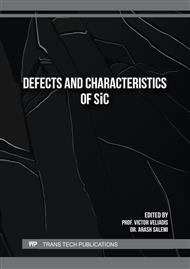[1]
H. Abderrazak and E. Bel Hadj Hmida, Silicon Carbide : Synthesis and Properties, in: Properties and Application of Silicon Carbide, (2011).
DOI: 10.5772/15736
Google Scholar
[2]
F. Cheynis, E. Bussmann, F. Leroy, T. Passanante and P. Müller, Dewetting dynamics of silicon-on-insulator thin films, Physical Review B, 84, 245439 (2011).
DOI: 10.1103/physrevb.84.245439
Google Scholar
[3]
D. T. Danielson, D. K. Sparacin, J. Michel and L. C. Kimerling, Surface-energy-driven dewetting theory of silicon-on-insulator agglomeration, Journal of Applied Physics, 100, 083507 (2006).
DOI: 10.1063/1.2357345
Google Scholar
[4]
D. J. Srolovitz and S. A. Safran, Capillary instabilities in thin films. I. Energetics, Journal of Applied Physics, 60 (1986) 247-254.
DOI: 10.1063/1.337689
Google Scholar
[5]
F. Mu, K. Iguchi, H. Nakazawa, Y. Takahashi, M. Fujino, R. He and T. Suga, A comparison study: Direct wafer bonding of SiC-SiC by standard surface-activated bonding and modified surface-activated bonding with Si-containing Ar ion beam, Applied Physics Express, 9(8), 081302 (2016).
DOI: 10.7567/apex.9.081302
Google Scholar
[6]
W. Zhang, C. Zhang, J. Wu, F. Yang, Y. An, F. Hu and J. Fan, Low Temperature Hydrophilic SiC Wafer Level Direct Bonding for Ultrahigh-Voltage Device Applications, Micromachines, 12, (2021) 1575.
DOI: 10.3390/mi12121575
Google Scholar
[7]
T. Shimatsu and M. Uomoto, Room Temperature Bonding of Wafers with Thin Nanocrystalline Metal Films, ECS Transactions, 33, (2010) 61-72.
DOI: 10.1149/1.3483494
Google Scholar
[8]
M. Uomoto and T. Shimatsu, Atomic diffusion bonding of Si wafers using thin Nb films, Japanese Journal of Applied Physics, 59 (2020).
DOI: 10.7567/1347-4065/ab4b1c
Google Scholar
[9]
N. Daval, A. Drouin, H. Biard and L. Viravaux, SmartSiC™ for Manufacturing of SiC Power Devices, 2022 6th IEEE Electron Devices Technology & Manufacturing Conference (EDTM), (2022).
DOI: 10.1109/edtm53872.2022.9798032
Google Scholar
[10]
W. Rasband, ImageJ, U.S National Institutes of Health, https://imagej.nih.gov/ij/, Bethesda, Maryland, USA, 1997-2018.
Google Scholar
[11]
N. Cherkashin, A. Louiset, A. Chmielewski, D. Kim, C. Dubourdieu and S. Schamm-Chardon, Quantitative mapping of strain and displacement fields over HR-TEM and HR-STEM images of crystals with reference to a virtual lattice, Ultramicroscopy, 253, 113778 (2023).
DOI: 10.1016/j.ultramic.2023.113778
Google Scholar
[12]
J. Hoβ, J. Baumann, M. Berendt, U. Graupner, R. Köhler, J. Lossen, M. Thumsch and E. Schneiderlöchner, Sputtering of silicon thin films for passivated contacts, AIP Conference Proceedings, 2147, 040007 (2019).
DOI: 10.1063/1.5123834
Google Scholar
[13]
M. Le Cunff, F. Rieutord, D. Landru, O. Kononchuk and N. Cherkashin, High temperature evolution of a confined silicon layer, Journal of Applied Physics, 135, 245301 (2024).
DOI: 10.1063/5.0205878
Google Scholar
[14]
N. Cherkashin, T. Denneulin and M. Hÿtch, Electron microscopy by specimen design: application to strain measurements, Scientific Reports, 7, 12394 (2017).
DOI: 10.1038/s41598-017-12695-8
Google Scholar
[15]
Y. Kuz'ma, V. Lakh, V. Markiv, B. Stadnyk and E. Gladyshevskii, X-ray diffraction study of the system tungsten-rhenium-carbon, Soviet Powder Metallurgy and Metal Ceramics, 2, (1964) 286-292.
DOI: 10.1007/bf00774034
Google Scholar
[16]
Z. Zhang, X. Duan, D. Jia, Y. Zhou and S. v. d. Zwaag, On the formation mechanisms and properties of MAX phases: A review, Journal of the European Ceramic Society, 41(7), (2021) 3851-3878.
DOI: 10.1016/j.jeurceramsoc.2021.02.002
Google Scholar
[17]
D. Bandyopadhyay, The Ti-Si-C system (Titanium-Silicon-Carbon), Journal of Phase Equilibria and Diffusion, 25( 5), (2004) 415-420.
DOI: 10.1361/15477030420890
Google Scholar
[18]
C. Rawn, E. Payzant, C. Hubbard, M. Barsoum and T. El-Raghy, Structure of Ti3SiC2, Materials Science Forum, 321, (2000) 889-892.
DOI: 10.4028/www.scientific.net/msf.321-324.889
Google Scholar
[19]
K. Nakamura and M. Yashima, Crystal structure of (NaCl)-type transition metal monocarbides MC (M=V, Ti, Nb, Ta, Hf, Zr), a neutron powder diffraction study, Materials Science and Engineering B, 148(1), (2008) 69-72.
DOI: 10.1016/j.mseb.2007.09.040
Google Scholar


